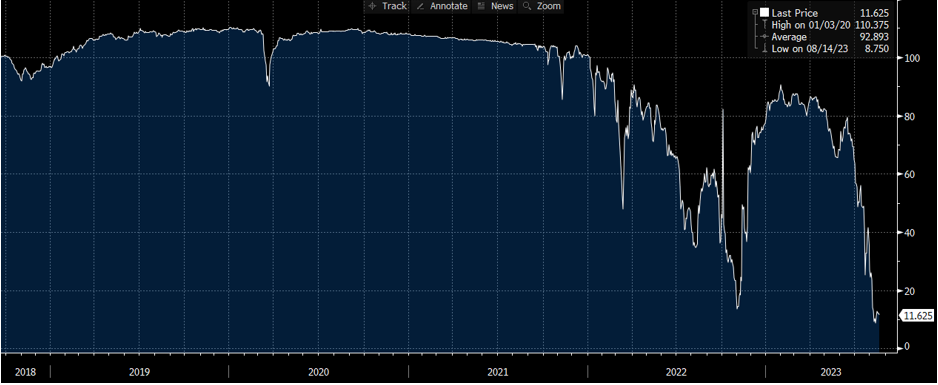A Treacherous Country Garden
August 24, 2023

In 2021, Yang Huiyan was worth approximately $30 billion and was the richest woman in Asia, according to the Financial Times. China’s real estate market was booming, and she was the largest shareholder of Country Garden, China’s largest property developer. Fast forward to August 2023, per the South China Morning Post, Country Garden missed two USD coupon payments worth $22.5 million and suspended trading on 11 of its onshore bonds.1 The company now faces more than $2.5 billion in coupon payments and bond maturities before the end of the year. If Country Garden cannot resolve those interest payments during its 30-day grace period, it will have triggered an event of default on its bonds and the once richest woman in Asia’s equity may be at stake of being wiped out. As seen in this week’s chart, the bond market is not optimistic that there will be a quick resolution. Country Garden’s first lien secured bonds that mature in less than six months are currently trading near $11 versus a claim of $100 due in January 2024.
Country Garden’s troubles are not company specific, as evidenced by Evergrande’s bankruptcy filing a few days ago. China Evergrande Group, also one of the country’s largest real estate development companies, had been dealing with its own debt crisis since 2021. The Chinese real estate market had been a huge growth engine for the country, but perhaps the ghost cities and empty apartment buildings are catching up with the country’s ability to fund and build more developments. Per an article in The Wall Street Journal (WSJ), approximately one in five apartments in China’s cities were estimated to be empty in 2018. Another example is a high-speed rail line that was built, which cost millions of dollars; however, it was never put into use due to such low demand and high costs to operate.
Additionally, the WSJ has reported on some of China’s poorest provinces’ use of significant debt to fund construction that is now seemingly underutilized. Guizhou province had a gross domestic product per capita of less than $7,200 in 2022, yet it has more than 1,700 bridges and 11 airports. For comparison purposes, the aforementioned is more than the total number of airports in China’s top four cities. At the end of last year, that same province had an estimated $388 billion in debt and unsurprisingly had to ask for aid from the central government this year. In hindsight, it seems obvious that it will be difficult for those borrowings to be paid back without government aid and perhaps may be a barometer for other investments throughout the country.
The collapse in the valuations, cash flows and growth potential for these major Chinese companies has been rippling throughout other parts of the Chinese economy. According to the WSJ, three publicly listed companies said they recently did not receive payments on their wealth management products. The missed payments are worrying investors in China’s trust industry, which had been a source of funding for property developers. If new money will be more difficult to raise and/or more expensive, it should also slow the growth in China — even when the demand returns. Additionally, investors that still have investments in these trusts may be at risk of material losses of savings. Many investors globally were counting on continued growth out of China and this may prove to be difficult with the current economic backdrop. This could also explain why the inventory destocking felt by basic industry companies over the last 12 months has been persisting, and perhaps may be more reflective of diminished global demand for products.
Key Takeaway:
Lower global demand, driven by weakness in China, should provide relief to the persistently high inflation we’ve been experiencing. However, that would not bode well for the goldilocks soft landing narrative that markets seem to be pricing in currently. Equity markets have come off a bit from the recent highs, with high-yield and investment-grade corporate bond spreads retracing a bit from their tights. With that said, a global slowdown and lower earnings do not seem to be priced into risk markets. If the Chinese real estate and investor issues become even more pervasive and longer lasting, watch out for markets to start to price in more risk. I will continue to invest throughout the cycles and look for companies that have the wherewithal to survive credit and economic cycles.
Source:
1South China Morning Post – Country Garden crisis: why a default isn’t the worst possible news for embattled Chinese property developer; 8/21/23
This material is for informational use only. The views expressed are those of the author, and do not necessarily reflect the views of Penn Mutual Asset Management. This material is not intended to be relied upon as a forecast, research or investment advice, and it is not a recommendation, offer or solicitation to buy or sell any securities or to adopt any investment strategy.
Opinions and statements of financial market trends that are based on current market conditions constitute judgment of the author and are subject to change without notice. The information and opinions contained in this material are derived from sources deemed to be reliable but should not be assumed to be accurate or complete. Statements that reflect projections or expectations of future financial or economic performance of the markets may be considered forward-looking statements. Actual results may differ significantly. Any forecasts contained in this material are based on various estimates and assumptions, and there can be no assurance that such estimates or assumptions will prove accurate.
Investing involves risk, including possible loss of principal. Past performance is no guarantee of future results. All information referenced in preparation of this material has been obtained from sources believed to be reliable, but accuracy and completeness are not guaranteed. There is no representation or warranty as to the accuracy of the information and Penn Mutual Asset Management shall have no liability for decisions based upon such information.
High-Yield bonds are subject to greater fluctuations in value and risk of loss of income and principal. Investing in higher yielding, lower rated corporate bonds have a greater risk of price fluctuations and loss of principal and income than U.S. Treasury bonds and bills. Government securities offer a higher degree of safety and are guaranteed as to the timely payment of principal and interest if held to maturity.
All trademarks are the property of their respective owners. This material may not be reproduced in whole or in part in any form, or referred to in any other publication, without express written permission.

